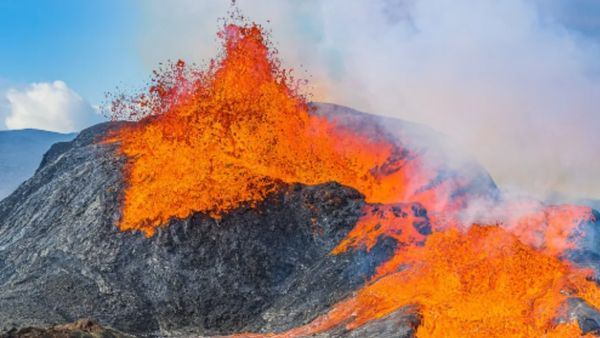Novel Technique Forecasting Volcanic Eruptions Magma Foams
Thanks to magma "foams," an unique method for predicting volcanic explosions is now possible.

Novel Technique Forecasting Volcanic Eruptions Magma Foams. According to a seven-year study, changes in particular isotopes connected to magmatic “foams” can be used to forecast volcanic unrest.
Scientists have developed a method to monitor the behavior of magma deep within the Earth’s crust by analyzing the ratio of atoms in particular gases produced by volcanic fumaroles (gaps in the surface of the planet).
The new technique, developed by a team at the University of Tokyo and published in Nature, could show when things are “heating up,” similar to getting a blood test to check your health. Significantly, it might help with volcano eruption forecasting in the future.
Volcanic explosions are unpredictable and deadly. Could recent discoveries alter this?
Researchers have recently demonstrated that by tracking variations in the argon-40 to helium-3 ratio, they can estimate how foamy a magma is. The chance of a certain sort of eruption can therefore be predicted based on the level of “foaminess.”
We came to know that the helium isotope ratio sometimes changes from a low value, comparable to the helium found in the Earth’s crust, to a high value, comparable to that in the Earth’s mantle, whenever the activity of magma increases, according to professor Hirochika Sumino from Research Center for Advanced Science and Technology and coauthor of a study.
But he continued, “We didn’t understand why we had more mantle-derived helium during magmatic instability.
The team monitored gases from six fumaroles around the active Kusatsu-Shirane volcano for 7 years
Six fumaroles close to the active Kusatsu-Shirane volcano in Gunma Prefecture, which is situated around 150 kilometers northwest of Tokyo, were chosen by Sumino and his team to be the source of their gas monitoring. From 2014 to 2021, samples were taken here at intervals of a few months.
After gathering the samples, they went back to the lab and analyzed them using cutting-edge equipment called a noble gas mass spectrometer. This allowed them to precisely calculate the isotopic compositions, like ultra-trace isotopes like helium-3, which are often present in the mantle in greater quantity than in the crust or air.
Magma foam controls the magmatic gas supply to a volcano’s hydrothermal system
“We were successful in identifying changes in the argon-40/helium-3 ratio, which are indicative of magmatic disturbance. We found that the ratio represents how much the magma underneath is foaming, producing bubbles of volcanic gases that separate from the liquid magma, using computer models “Sumino stated.
In an ironic twist, he continued, “how much magma foams influences how much magmatic gas is delivered to the hydrothermal system beneath a volcano as well as how buoyant the magma is.
The amount of gas supplied to the hydrothermal system below a volcano, according to the researcher, is correlated with the likelihood of a “phreatic eruption.” A rise in water pressure within the hydrothermal system is what generates a phreatic eruption.
The buoyancy of the magma also affects how quickly it ascends.
To fully understand what is happening with the magma, “we are looking at actual material that was directly produced from the magma.”
The usual geophysical techniques represented by observations of earthquakes and crustal deformation are comparable to listening to the chest and measuring body size when applied to volcanoes, according to Sumino.
He continued by saying that these tests make it difficult to identify the health problem that is generating a rumble in your chest or a sudden increase in weight in these circumstances. Simply said, they lack detail.
“Comparable to a breath or blood test, however, is the analysis of the chemical and isotope composition of the elements in fumarolic gases. Because of this, we can precisely determine what is happening with the magma by examining actual material that was created from the magma “said he.
For on-site, real-time analysis of noble gas isotope ratios, we are currently developing a portable mass spectrometer–
The team must currently gather gas samples in the field and bring them back to the lab for examination. They demonstrate how time-consuming and difficult this procedure is.
In light of this, Sumino plans to develop a new tool that would enable them to carry out the same analysis in the field and in real-time.
- Astronomy Exclusive Project Sees 224.09M boost From NASA
- Geo Magnetic Storms
- Modern Warfare 2 campaign review: Almost a worthy successor
Sumino said, “We want to be able to identify changes in magma activity as soon as feasible. In order to monitor the ratios of noble gas isotopes in fumarolic gases in-situ and in real-time, we are now constructing a portable mass spectrometer.
With this new equipment, “our next step is to build a noble gas analysis methodology, making it a reality that all current volcanoes — at least those that have the potential to cause tragedy to local populations — are monitored 24 hours a day, seven days a week.”
Summary
A useful Parameter to track the progress of a degassing magma is the 3He/40Ar* ratio of fumarolic gases. It is crucial for comprehending the complex processes underlying volcanic unrest and may help to spot signs of an impending eruption. The use of noble gas and carbon isotopic compositions for tracking magmatic-hydrothermal systems is further supported by these findings.






